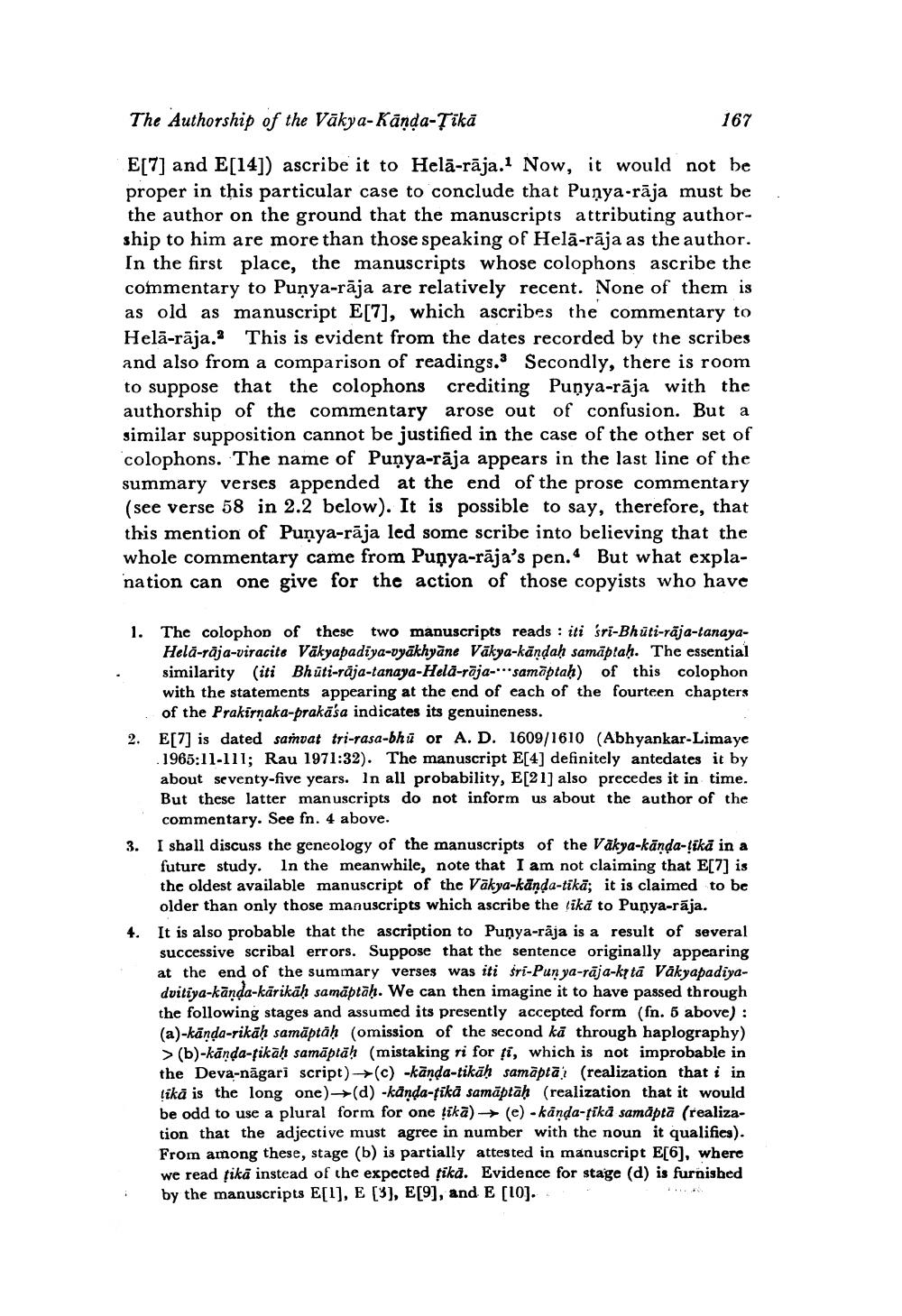Book Title: Authorship Of Vakya Kanda Tika Author(s): Ashok Aklujkar Publisher: Ashok Aklujkar View full book textPage 3
________________ The Authorship of the Vākya-Kānda-Tikā 167 E[7] and E[14]) ascribe it to Helā-rāja. Now, it would not be proper in this particular case to conclude that Punya-rāja must be the author on the ground that the manuscripts attributing authorship to him are more than those speaking of Helā-rāja as the author. In the first place, the manuscripts whose colophons ascribe the commentary to Punya-rāja are relatively recent. None of them is as old as manuscript E[7], which ascribes the commentary to Helā-rāja. This is evident from the dates recorded by the scribes and also from a comparison of readings. Secondly, there is room to suppose that the colophons crediting Punya-rāja with the authorship of the commentary arose out of confusion. But a similar supposition cannot be justified in the case of the other set of colophons. The name of Punya-rāja appears in the last line of the summary verses appended at the end of the prose commentary (see verse 58 in 2.2 below). It is possible to say, therefore, that this mention of Punya-rāja led some scribe into believing that the whole commentary came from Punya-rāja's pen. But what explanation can one give for the action of those copyists who have 1. The colophon of these two manuscripts reads : iti sri-Bhūti-rāja-tanaya Helā-rāja-viracite Vākyapadiya-vyākhyāne Vākya-kāndaḥ samāptah. The essential similarity (iti Bhūti-rāja-tanaya-Hela-raja-samāptah) of this colophon with the statements appearing at the end of each of the fourteen chapters of the Prakirnaka-prakāśa indicates its genuineness. 2. E[7] is dated saivat tri-rasa-bhū or A.D. 1609/1610 (Abhyankar-Limaye 1965:11-111; Rau 1971:32). The manuscript E[4] definitely antedates it by about seventy-five years. In all probability, E[21] also precedes it in time. But these latter manuscripts do not inform us about the author of the commentary. See fn. 4 above. 3. I shall discuss the geneology of the manuscripts of the Vakya-kānda-lika in a future study. In the meanwhile, note that I am not claiming that E[7] is the oldest available manuscript of the Vākya-kända-tikā; it is claimed to be older than only those manuscripts which ascribe the tikā to Punya-rāja. It is also probable that the ascription to Punya-raja is a result of several successive scribal errors. Suppose that the sentence originally appearing at the end of the summary verses was iti sri-Pun ya-rāja-ky tā Vākyapadiyadvitiya-kānda-karikāḥ samāptāḥ. We can then imagine it to have passed through the following stages and assumed its presently accepted form (fn. 5 above): (a)-kānda-rikāḥ samāptāḥ (omission of the second kā through haplography) > (b)-kānda-ţikāḥ samāptāṁ (mistaking ri for fi, which is not improbable in the Deva-nagari script) (c) -kānda-tikāḥ samāpta (realization that i in likā is the long one)+(d) -kända-ţikā samāptāḥ (realization that it would be odd to use a plural form for one tika) + (e)-kända-ţika samăptă (realization that the adjective must agree in number with the noun it qualifies). From among these, stage (b) is partially attested in manuscript E[6], where we read tikā instead of the expected tikā. Evidence for stage (d) is furnished by the manuscripts E[1], E [3), E[9], and E [10]. .Page Navigation
1 2 3 4 5 6 7 8 9 10 11 12 13 14 15 16 17 18 19 20 21 22 23 24
